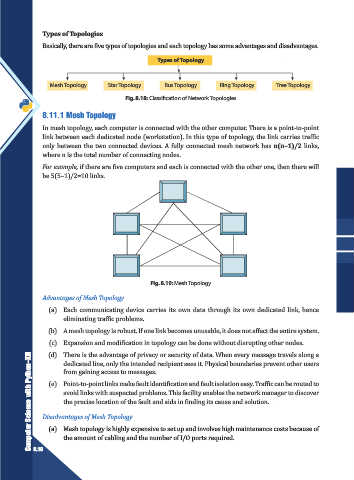Page 172 - PYTHON-12
P. 172
Types of Topologies
Basically, there are five types of topologies and each topology has some advantages and disadvantages.
Types of Topology
Mesh Topology Star Topology Bus Topology Ring Topology Tree Topology
Fig. 8.18: Classification of Network Topologies
8.11.1 Mesh Topology
In mesh topology, each computer is connected with the other computer. There is a point-to-point
link between each dedicated node (workstation). In this type of topology, the link carries traffic
only between the two connected devices. A fully connected mesh network has n(n–1)/2 links,
where n is the total number of connecting nodes.
For example, if there are five computers and each is connected with the other one, then there will
be 5(5–1)/2=10 links.
Fig. 8.19: Mesh Topology
Advantages of Mesh Topology
(a) Each communicating device carries its own data through its own dedicated link, hence
eliminating traffic problems.
(b) A mesh topology is robust. If one link becomes unusable, it does not affect the entire system.
(c) Expansion and modification in topology can be done without disrupting other nodes.
(d) There is the advantage of privacy or security of data. When every message travels along a
Computer Science with Python–XII 8.18 (e) Point-to-point links make fault identification and fault isolation easy. Traffic can be routed to
dedicated line, only the intended recipient sees it. Physical boundaries prevent other users
from gaining access to messages.
avoid links with suspected problems. This facility enables the network manager to discover
the precise location of the fault and aids in finding its cause and solution.
Disadvantages of Mesh Topology
(a) Mesh topology is highly expensive to set up and involves high maintenance costs because of
the amount of cabling and the number of I/O ports required.

